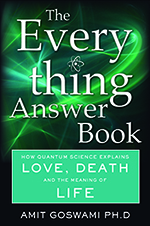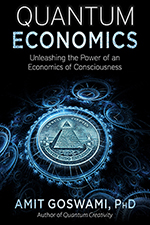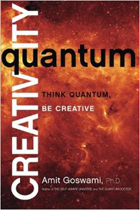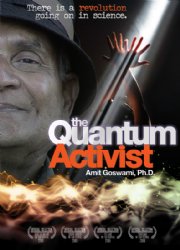In the olden days of consciousness research millennia ago, all participants and would-be-teachers had a one-pointed goal—self-realization. This was their dharma. For self-realized teachers there was only one way of removing ignorance in those days, only one archetype to explore creatively for transformation. The creative process was not known, however; one had to follow the great teachers’ path, and most times, those paths took one only partway. So eventually, the seeker had to chart his or her own path. The whole process took a considerable amount of time.
Self-realization in those days mostly used the intellect and the creative insight came in the form of an enlightening wisdom specific to the seeker whose ultimate message was the idealist metaphysics: consciousness is the ground of all being. This intellectual exploration was later called the wisdom path—jnana (pronounced gnyana in Sanskrit with a nasal hard g sound) Yoga.
Today, quantum science has made it easy. Jnana yoga is not needed. Instead, you can follow science’s method for finding truth: theory and experiment instead of theory and experience. Saves you a considerable amount of time.
The dharma for professionals other than teachers depended on the profession: the warriors pursued the archetype of power, businesspeople the archetype of abundance, artists the archetype of beauty, and so forth.
All this changes in quantum science. Ignorance is not defined solely by the ignorance of the true nature of the self. Ignorance is mistaking the self as me—an object—and forget the subject “I” that is behind the me. Also, ignorance that the “I” can be temporarily expanded to include the you-other to make a “we.” Caring for the other expands our self-perception to include not only relationships of intimacy but also to the community. This not recognizing the community-self is behind the societal and environmental crisis today.
Quantum science and empirical data seem to suggest a chronological order of archetypal exploration that a transformation-seeker can engage. The step-by-step process makes it much easier to gauge success and maintain motivation.
For the educationist, the teacher, the final goal is wholeness; however, one can work on wholeness while exploring the earlier archetypes in the chronology revealed by the data.
The first step is to straighten out how to think, how to straighten out all worldview confusion. This takes a considerable belief system re-visioning.
In earlier chapters, we have touched upon the basics of quantum physics and quantum science as well as the quantum worldview. In this chapter let’s start with some verifying data.
Starting with the nineteen eighties new data started coming in challenging the basic tenets of scientific materialism; at the same time, maverick theoretical scientists started to explore alternative avenues fora paradigm shift in science.
The new data and new ideas are now coming in profusely in support of the quantum science paradigm from everywhere: physics, biology, neuroscience, psychology, even computer science, what have you. We will give you a list:
- Quantum physics: An experiment by a group of physicists headed by Alain Aspect has demonstrated a phenomenon called nonlocality: signal-less communication.
- Quantum physicsand quantum measurement theory: Using an approximation to the quantum equation, the physicist David Bohm mathematically demonstrated the existence of a domain of reality (implicate order) outside of space and time (explicate order). Systems theorist Ervin Laszlo saw the quantum domain of potentiality as a nonlocal quantum field. Amit Goswami generalized earlier ideas of von Neumann and showed that the quantum field is nothing but consciousness and it is the ground of being of not only material possibilities but also quantum possibilities of our experiences of meaning, feeling, and intuition. Science within consciousness was born with the explanation of how consciousness creates the material world via downward causation.
- Psychology: the phenomenon of blindsight—a cortically blind person is found to avoid an obstacle on his way while walking but denies that he saw the obstacle–was observed in 1969 and confirmed Freud’s old idea of the unconscious once dismissed as voodoo psychology. Quantum science is able to explain the science behind the unconscious: it is the unmanifest quantum domain of potentiality. In other words, unconscious is consciousnesswithout awareness, without subject-object split.
- Neuroscience: A whole bunch of neuroscience experiments have demonstrated that electrical activity can be nonlocally (without electrical signals) can be transferred from one brain in meditative connection with another. This is called transferred potential. The first such demonstration was due to the neuroscientist Jacobo Grinberg-Zylberbaum and collaborators. The experiment verified that the brains of two observers can be correlated and the correlation can be maintained if the observers meditate with the intention for nonlocal communication.
- Biology: How to differentiate life from nonlife? This sentience—the ability to experience the world as conscious subject–is then the property that differentiates between life and nonlife.
What is feeling? Biologists have known for a long time that even single cell creatures have feeling, they feel their way about their environment. Harold Baxter demonstrated that plants could feel pain.
We have the living world without the cortical brain, from a single living cell to mammals below the primates in the evolutionary totem pole.
Instead of the mind, these living beings without the neo-cortex connect to Consciousness via the vital—one of the organizing principles of life. We experience the movement of the vital software as feeling.
- Biology: While trying to find explanation for cell differentiation—why cells in different organs make different sets of proteins even though all cells possess identical genes—Rupert Sheldrake discovered nonmaterialmorphogenetic fields. Materialist scientists threatened to burn Sheldrake’s book; the controversy was dualism implicit in Sheldrakes theory. Goswami incorporated Sheldrake’s discovery in the science within consciousness resolving the controversy.
Human fetus begins as a one cell embryo called zygote. All our organs are built from that one cell becoming many by cell division. In this way all cells have the same genes. Then how are they differentiated so cells in different organs activate different sets of genes to make proteins appropriate for the functioning of the organ to which it belongs? Different software you say. Ok. The plot thickens with mystery however, when you realize that often organs in different parts of the body act in instant coordination suggesting signal-less communication. Material local interactions cannot simulate nonlocality, so we need a nonphysical quantum field to help Consciousness organize the organ software. This nonmaterial quantum field is what Sheldrake called morphogenetic field.
- Biology: A series of experiments in biologyhas verified Sheldrake’s idea that the operating software of biological organs is epigenetic; the prefix epi means outside.
- Physiology: The result of repeated experiences of feeling of the vital movements of the morphogenetic fields along with the sensing of the organ physiology gives us the vital software that turns on organ physiology.
- Yoga Psychology: The experience of organ physiology together with vital software occurs at points of the body roughly along the spine. These points are called the chakras first discovered in yoga psychologymillennia ago. Amit Goswami has discovered the quantum science of the chakras.
- Biophysics: A new technique called Kirlian photography has demonstrated that not only do we have a bioelectric layer on our skin but also the field of this layer is sensitive to our feelings in this way providing a way of measuring feelings.
- Directed mutation: The biologist John Cairns and his collaborators discovered that a colony of simple bacterium, when proffered lactose that they cannot digest, hasten up their mutation rate for mutation into another species that can digest lactose. They aptly called the process directed mutation. Obviously, the experiment verifies the idea of downward causation by consciousness.
- Neuroscience: Experiments of neuroscience via the technique of magnetic resonance imaging (MRI) have demonstrated that brain states imaged are sensitive to mental states people simultaneously experience. In other words, mental experience, mind, is measurable.
- Neuroscience: Experiments on neuroscience based on the new technology called functional magnetic resonance imaging (fMRI) has revealed that our brain can operate in two modalities: local (centered around being that communicates with signal and nonlocal centered around being that communicates without signals and therefore involves many distant parts of the brain simultaneously.
- Neuroscience: The brains of people in acts of intelligence show more synaptic connections among different parts suggesting nonlocality and expansionof consciousness.
- Quantum physics: The quantum physicist Niels Bohr theorized that when electrons jump from one atomic orbit to another, they do not go through the intervening space. This is called a quantum leap. Recently, it has been verified that when electrons traverse across an energy barrier in a transistor, they do not tunnel through as previously theorized. Instead, the new measurements confirmed the quantum leap theory.
- CreativityResearch: Decades of case studies by creativity researchers have revealed that creative insights come to people discontinuously. Amit Goswami explained the discontinuity of creative experiences as quantum leaps of meaningful thoughts leading to new meaning.
- Biological Evolution: biologists have discovered fossil gaps of evolution—the fossil data is not continuous and consequently nor is evolution, as once thought, as in Darwin’s theory. The biologists Niles Eldredge and Stephen Gould proposed the theory of punctuated equilibrium—evolution in addition to continuous prose of Darwinian vintage occasionally display abrupt punctuation marks. Amit Goswami has demonstrated the gaps—punctuation marks of evolution—consists of quantum leaps of creativity.
- Health science: many cases of spontaneous healing without any medical intervention were discovered. The physician Deepak Chopra identified them as a demonstration of discontinuous quantum healing—quantum leaps of healing
.
- Neuroscience: the neuroscientist Mario Bureaugard has demonstrated that when Carmelite nuns have out-of-the-body experiences, there is a neural correlate that tells us exactly that, their brain center of body awareness—the parietal lobe–goes numb, in this way validating the phenomenon of out-of-the-body experience much touted in the spiritual literature.
- Parapsychology: Distant viewing experiments—one psychic sees an object in a town square and makes a mental image; another psychic is able to draw a picture of the object while sitting in a closet at a distance obviously without any local signals from the other. This confirms the much-touted phenomenon of mental telepathy. Quantum science provides an explanation: the two psychics are correlated via intention of direct communication. For correlated electrons, the correlation breaks up as soon as we measure. In the case of humans, the psychics maintain the correlation by ongoing meditative intention on direct communication.
- Health science: Healing at a distance has been demonstrated by the physician Randolph Byrd; people pray for the healing of patients in Denver; this hastens up the patients’ recovery from cardiac surgery in San Francisco.
- Artificial Intelligencetheory: the philosopher John Searle theorized that computers cannot process meaning; this was verified via mathematics by the physicist Roger Penrose. If the brain works like a computer as it seems to, then it follows that the brain cannot cognize.
- Cognitive science: the cognitive scientist Tony Marcel demonstrated that processing ambiguous words with or without conscious awareness affect people’s cognition time. If the brain could cognize, it would make no difference whether people are consciously aware of an event or not. Conclusion: brain cannot cognize.
- Reincarnation: This is a very old idea that originated in India. Some essence of us somehow continues after our death and transmigrates to an aborning baby in some future time and place; in other words, in some sense we survive the death of our current physical body and reincarnate into another physical body in the future. This theory was languishing as an evocative idea and nothing more, although from time to time there were strange stories of little children recalling incidents from their past lives. In the twentieth century, the psychiatrist Ian Stevenson took the idea seriously and established definitive data that what these children described really happened. Amit Goswami has theoretically explained this phenomenon with the concept of nonlocal memory of learning. The brain researcher Karl Lashley has demonstrated the validity of the concept of nonlocal of learning.
- Jungian Psychology of Collective unconscious. Jungdiscovered that in some evocative big dreams, we all have the experience of remembering shared memory, we see universal symbols that triggers in us the same evocative archetypal resonance. Dreams of angels, gods and goddesses fall in this category. To explain the data, Jung theorized that the symbols are a part of humanity’s collective unconscious; Amit Goswami further theorized that the symbols are representations of the Platonic archetypes and explained how our ancestors could be nonlocally connected while they underwent archetypal transformation to make collective nonlocal memory. We will call these representations Jungian archetypes for future reference.
- Synchronicity: another great theoretical idea from Jung. They are incidences of the occurrence of a physical event simultaneously and coincidentally with somebody’s mental revelation of meaning. In other words, synchronicities are examples of meaningful coincidences between something physical and something mental. You must wonder: are they due to a common cause? Quantum science says yes. The common cause is nonlocal Consciousness. We cannot verify synchronicity via laboratory experiments. But if you are open to them, you will easily find plenty of experiential confirmation of the idea.
- Inner Creativity: Hero’s Journey. The mythologist Joseph Campbell discovered the myth of the hero’s journey as a universal journey of inner creativity and transformation. Carl Jungdiscovered the details.
We could go on and on, but you get the picture. Experimental data is so important to convince yourself of a new idea. Take the case of vital energy. It is the movement associated with feeling; it feels like energy. If we call it vital energy who can object? But when we say it is nonphysical, you hesitate if you have a belief that all energy is physical, all energy is related to movement of matter. But when you examine a Kirlian photograph of your finger tip and can see for yourself how the photograph changes as your mood changes and you cannot explain this in any purely physical way, like moisture on your finger, people tried you know, then you are more prone to admit what Hamlet said to Horatio: there are more things in heaven and earth than are dreamt of in your philosophy.
Or take the case of nonlocality. For decades the parapsychology experiments have always been debunked by the “skeptical inquirers” for one reason or another, mostly because a little subjectivity is always involved. But when you see the data on transferred potential and see the similarity of EEG readings of the brain waves of two guys, one sitting in an electrically impervious Faraday chamber, and yet only the other guy has seen light flashes, you do a double take (fig. 4a). Electrical activity can be transferred from one brain to another simply because the two people are continuously meditating with the intention of direct nonlocal communication during the experiment? Unbelievable! But look, when the two subjects do not meditate (control subjects), there is no transferred potential (3b)
What is experimental proof? Long time ago, it was seeing is believing. Copernicus and instrumentation changed all that. Instruments can amplify and this expands our ability of seeing. But then came the idea of quark; you cannot see it even with an electron microscope because it is always confined; it never sees daylight. The mindset had to change before they gave a Nobel prize to the physicist who led the group who did the crucial experiment that established the existence of quark via an indirect measurement, because there was no other explanation. This change in mindset is enabling us to develop data for quantum science within consciousness.
And now the most welcome news for all educationists of idealist values: notice this !one scientific theory called quantum science has been able to integrate all the alternative avenues of recent times alluded to above under one umbrella. This is the most convincing piece of data. Coincidentally, this new science, also completely validates the philosophy of idealism that the ancient seers discovered via experience.
….. excerpts from ‘Hero’s Journey: Quantum Style’



